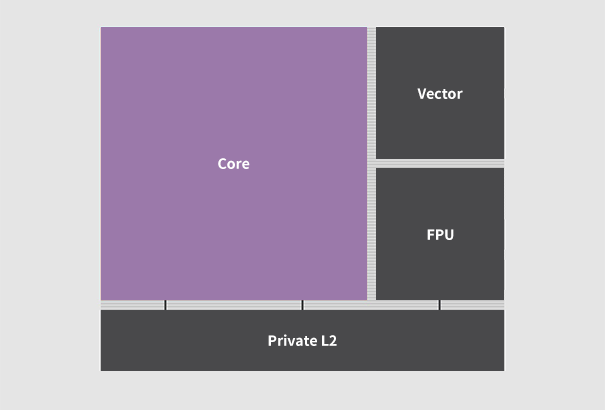StarFive has just announced customers’ delivery of the 64-bit RISC-V Dubhe core based on RV64GC ISA plus bit manipulation, user-level interrupts, as well as the latest Vector 1.0 (V) and Hypervisor (H) instructions.
StarFive Dubhe can be clocked up to 2 GHz on a 12nm TSMC process node, and the company also released performance numbers with a SPECint2006 score of 8.9/GHz, a Dhrystone score of 6.6 DMIPS/MHz, and a CoreMark score of 7.6/MHz. A third-party source told CNX Software it should be equivalent to the SiFive Performance P550 RISC-V core announced last summer, itself comparable to Cortex-A75.
StarFive Dubhe highlights:
- Typical frequency – 2.0 GHz @ TSMC 12nm
- “Industry-leading” Power and Area Efficiency (TSMC 12nm)
- RISC-V Vector Extension
- Data types: floating point, fixed point and integer
- VLEN=128-1024bits
- ALU & data path width=128 or 256 bits
- Full vector register grouping (LMUL) support
- RISC-V Virtualization Extension
- Pre-integrated Multi-Core with Memory Coherency Support
That’s not super detailed, but the company also lists some target applications with edge & cloud data centers (e.g. BMC, enterprise & computational storage), 5G infrastructure and base station, wireless access points, V2X communication, as well as Artificial Intelligence (AI) and Machine Learning (ML) for autonomous vehicles, robots, computer vision, and more.
StarFive has licensing agreements with SiFive, while being free to license its own RISC-V cores like the Dubhe, and that’s why you’ll find Dubhe together with SiFive U-Series, S-Series, etc.. on StarFive CPU cores page. Besides CPU IP, StarFive also provides its own full SoCs like the SiFive U74 based StarFive JH7100 processor found in the VisionFive V1 board that has just launched. So I would not be surprised if we see a Dubhe single board computer by the end of 2022 or sometime in 2023.
Via LinuxGizmos

Jean-Luc started CNX Software in 2010 as a part-time endeavor, before quitting his job as a software engineering manager, and starting to write daily news, and reviews full time later in 2011.
Support CNX Software! Donate via cryptocurrencies, become a Patron on Patreon, or purchase goods on Amazon or Aliexpress. We also use affiliate links in articles to earn commissions if you make a purchase after clicking on those links.






> Dhrystone score of 6.6 DMIPS/MHz
Isn’t that nigh-identical to a Cortex A73?
A73 is 4.8 DMIPS/MHz, 6.6 would sit between an A75 and A77 so if true its quite impressive performance
However the comment about it being equivalent to a P550 contradict that because the P550 is < 4 DMIPS/MHz
Wonder what’s the score for A76. Since it also sit between A75 and A77.
There are no published scores for the A75, A76 or A77. ARM stopped publishing from the A75 onwards. Ive never tested an A76 core but I have benched A75 and A77 which came out at approx 6.1 and 7.3 DMIPS/MHz
> I have benched A75 and A77
Using which methodology? Dhrystone 2?
Yeah its not just compilers and libs either, Im not convinced that a lot of cheap SoC’s report their operating clocks accurately either, especially MTK based devices
Im not too concerned about absolute accuracy, I just wanted a relative comparison between the A35, 53, 57, 72, 73, 75 & 77 devices I had available. I tested using the same binary on the same OS image (except 4 different kernels, 2 mainline 5.10, 2 oem BSP 5.4) and the results I got were within a few % mostly of what Arm publishes for the earlier cores. Not hugely meaningful and split over broadcom, MTK, AML & Qualcom SoC’s but its what I could cobble together in an afternoon
This is what I ended up with if your interested, rounded to 1dp:
A35 – 1.7 DMIPS/MHz
A53 – 2.2 DMIPS/MHz
A57 – 4.1 DMIPS/MHz
A72 – 4.5 DMIPS/MHz
A73 – 4.8 DMIPS/MHz
A75 – 6.1 DMIPS/MHz
A77 – 7.3 DMIPS/MHz
> I tested using the same binary on the same OS image
Oh, then these scores are really something one can rely on to order different CPU cores 🙂
Wrt sysfs numbers that pretend to represent clockspeeds: no need to trust, simply measure next time…
Awesome thanks, I hadnt seen that project before. I was thinking of writing something similar then I didnt have the motivation once Id done the testing lol
Better thank Willy next time you encounter him here in the comments. BTW: I keep a collection of such clockspeed measurements here (but neither MTK nor Qualcomm included).
Hehe I don’t need to be thanked. Many of us used to be victims of some vendor scams (with amlogic and rockchip commonly leading the movement), and at least we can say that thanks to our collective efforts we all managed to put an end to this practice that’s just old memories by now. That was the exact reason why I originally created this tool, and I wanted to create a standard hardware assessment tool that I didn’t have to make since Thomas did it 🙂 And with Jean-Luc using it with each and every board under review there’s very little room for cheating without being instantly discovered nowadays. However it also taught us that we must continue to watch, otherwise the bad practices from the past might quickly come back due to marketing pressure.
History definitely has a way of repeating.
Whatever you do, just don’t make a repeat of ARM China.
Dubhe Linux SDK has been released
https://github.com/starfive-tech/meta-starfive/releases/tag/REL_DUBHE_SEPT2021
I think its performance should be around cortex a76